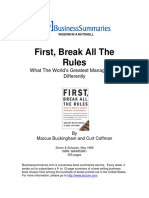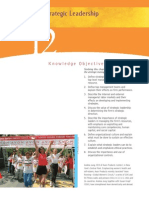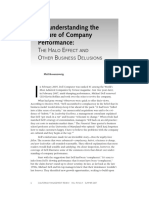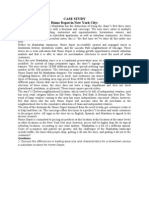Home Depot: Consider The Upside of Risk
Home Depot: Consider The Upside of Risk
Uploaded by
kouta0824Copyright:
Available Formats
Home Depot: Consider The Upside of Risk
Home Depot: Consider The Upside of Risk
Uploaded by
kouta0824Original Description:
Original Title
Copyright
Available Formats
Share this document
Did you find this document useful?
Is this content inappropriate?
Copyright:
Available Formats
Home Depot: Consider The Upside of Risk
Home Depot: Consider The Upside of Risk
Uploaded by
kouta0824Copyright:
Available Formats
1
ERM Case study
HOME DEPOT
Home Depot was founded in 1978 and grew to $40 billion in revenue in 20 years. By 1999,
however, growth and profits had stalled. In 2000, the board of directors brought in Bob Nardelli
as chief executive officer. Bob had had a successful career, rising to the top echelon of General
Electric. When he failed to win the position of CEO when Jack Welch retired, he left GE.
Consider the Upside of Risk
At Home Depot, Mr. Nardelli changed the culture. He implemented a military-style management
model. Thirteen percent of the company's employees had military experience, compared to 4
percent at Wal-Mart. More than 500 of the 1,100 employees hired into management between
2002 and 2006 had previously been junior military officers. By 2006, more than 100 of these
were store managers. Bob knew how to respond to risk. A person who has faced a shooting
enemy will be calm when dealing with a tough customer.
The military-style management was consistent with Mr. Nar- delli's philosophy. Home Depot
was following George Stalk's principles described in Hardball: Are You Playing to Play or Playing
to Win? Examples of the philosophy include (1) maneuvering competitors into positions and
markets where they are forced to invest heavily to stay competitive and (2) engaging weaker
rivals in a war of attrition, eventually forcing them out of business.
Lesson Learned: Mr. Nardelli aggressively pursued the upside of risk. This could be good.
Assign Risk Owners
As a result of the change in leadership, the culture at Home Depot changed dramatically. Prior to
2000, store managers had enormous authority. They were the risk owners on the front line of the
business. They used their knowledge of local conditions and, in many cases, their instincts, rather
than data and analytics, to run their operations. Beginning in 2000, most major decisions came
Irom the top. Headquarters measured performance, made decisions, and set goals, using analytics
such as margins of profit on products and the number of customers greeted at the door.
The new system was producing results. Between 2000 and 2005, sales at Home Depot rose 75
percent, and profits doubled. By 2006, the company was the world's third largest retailer, and its
success was attracting attention. In March 2006, Fortune magazine identified Home Depot as the
most admired specialty retailer for that year and named it the 15th most admired global corporation.
Lesson Learned: Risk ownership shifted from store managers to central staff who made major
decisions and to corporate committees with no direct accountability for results. Home Depot
moved away from identifying risk owners with accountability for risks. This might not be good.
Align Risk with the Business Model
At exactly the same time (March and April 2006) that the public press was taking favorable
notice of Home Depot, Saint Peter's University ran its first ever course on enterprise risk
management. The class noticed a failure at Home Depot to align risk responsibility with the
ERM Case study
business model. Committees and central staff were making decisions that were not vetted by
store management, including the new military-trained managers. Four teams of MBA candidates
undertook an ERM analysis of Home Depot. Would it confirm the positive picture?
The first symptom of a problem was the performance of the company's stock. It dropped 7
percent between 2001 and 2006. In contrast, Lowe's, a major competitor half the size of Home
Depot, saw its stock rise 210 percent over the same period.
The students looked inside the company itself. Inventory was sluggish at Home Depot.
Headquarters focused store managers on a single metricinventory turnover. To increase the
ratio, a store could either sell more goods or reduce its inventory. In a number of cases, store
managers stopped ordering inventory, and shelves were often empty of goods to sell. Here was a
complete failure to align risk management with the business model. Store owners should be
responsible for achieving goals, not managing ratios dictated by headquarters staff personnel.
A second failure to align risk with the business model involved directives to cut staffing costs.
The CEO ordered a reduction in the ratio of full time to part time from 70 percent to 50 percent
of total staffing. A savings would result by holding back on employees' health care benefits and
retirement contributions. This was a disaster for morale, a hard-to-quantify but real variable in
risk management.
Lesson Learned: Aligning risk categories with the business model provides accountability not
available when directives come from staff officers or committees. Who would be accountable,
other than the CEO, if Home Depot were to stumble?
Establish a Central Risk Function
The Saint Peter's MBA teams were effectively acting as a central risk function for Home Depot.
They found deteriorating conditions in the military-style atmosphere, accompanied by pressure
to perform and a failure of the company to make a real commitment to the workforce. All four
teams identified a culture of fear. It was accompanied by a whole new language that became part
of employee discussions, including these terms:
Aprons. Store workers themselves, described by their orange aprons. An apron is useful
but does not have to think.
Bob's Army. A reference to individuals in the store leadership program, where half of new
hires were former military personnel. What happened to individuals who were not former
military personnel? Not good for morale.
Bobaganda. A term describing company programming on televisions in employee break rooms. The
TVs continuously displayed tips to help staff sell more merchandise, gave warnings on proper and
improper behavior, and shared messages from senior managers and executives. The MBA teams
imagined a rather stressful time when employees tried to relax for a little while.
Home Despot. The ultimate sign of cultural problems. For disgruntled employees, this became the
undercover name of the company itself.
The teams scanned outside the company for data. As a final nail in the coffin, the class
discovered a University of Michigan Annual Customer Satisfaction Survey. 2In the 2001 survey,
Home Depot and Lowe's each scored a 75. In the 2006 survey, Home Depot dropped to 67, while
ERM Case study
Lowe's rose to 78. In spite of accolades in the media, Home Depot was not a hit with customers.
Its score put it in last place in the department store and discount store category.
Lesson Learned: Without a central risk function or other scanning mechanism, signs of future
danger can easily be missed.
Create a High-Tech Electronic Platform
Home Depot did not have a central risk function using a modern risk management platform.
From all indications, the organization did not understand the relationships among customer
dissatisfaction, employee low morale, and a centralized system of decision making that separated
risk owners from business decisions and strategies.
Lesson Learned: In a situation like this, things can go wrong.
Involve the Board
By all indications, the board of Home Depot was highly concerned with corporate responsibility
and a high degree of fiduciary responsibility. In April 2006, the Harvard Business Review ran a
lengthy article describing Home Depot as a model of corporate governance. The article claimed
that the company was committed to living values and recognized an ethical obligation to
shareholders, employees, customers, suppliers, and the communities where it operates. The
company claimed to follow strong corporate governance practices, compliance procedures, and
transparent financial reporting practices. It had a disclosure committee that pursued accurate and
complete financial reporting, it had a corporate compliance council that regularly monitored
internal controls, and it allowed only independent directors to serve on key board committees.
Lesson Learned: A board can have the best of intentions, but it ca n still miss important exposures
if it does not have an effective program of risk identification and sharing.
Standard Evaluation Process
Four teams of Saint Peter's MBA candidates performed an ERM evaluation of Home Depot in
April 2006. Every single team was negative about the future of Home Depot under the leadership
of Mr. Nardelli. It turned out that the ERM analysis was right on target. Within months, the Wall
Street Journal and other publications picked up the story. On January 2, 2007, only 10 months
after a Fortune magazine most-admired article, Home Depot and Robert Nardelli mutually agreed
on Nardelli's resignation as CEO after a six-year tenure. Nardelli resigned amid complaints over
his heavy-handed management style.
Lesson Learned: Even when all seems to be going well, a strong central risk scanning activity,
accompanied by a standard evaluation process, can help organizations identify problems.
Aftermath
The story of Mr. Nardelli did not end when he left Home Depot. He rebounded in August 2007
when Cerberus appointed him as the CEO of Chrysler Corporation.
3
Source: John J.Hampton Fundamentals of Enterprise risk management 2nd edition NY 2014
ERM Case study
You might also like
- Strategic Management ºA Case Study of AppleNo ratings yetStrategic Management ºA Case Study of Apple8 pages
- Why Selecting Leaders Is So Difficult in PracticeNo ratings yetWhy Selecting Leaders Is So Difficult in Practice13 pages
- Marketing Management: Business Unit Strategic PlanningNo ratings yetMarketing Management: Business Unit Strategic Planning32 pages
- rosenzweig-2007-misunderstanding-the-nature-of-company-performance-the-halo-effect-and-other-business-delusionsNo ratings yetrosenzweig-2007-misunderstanding-the-nature-of-company-performance-the-halo-effect-and-other-business-delusions16 pages
- Chapter 1 - Concept Questions and Exercises StudentNo ratings yetChapter 1 - Concept Questions and Exercises Student2 pages
- Managing for the Long Run (Review and Analysis of Miller and Le-Breton-Miller's Book)From EverandManaging for the Long Run (Review and Analysis of Miller and Le-Breton-Miller's Book)No ratings yet
- Strategic Management A Competitive Advantage Approach Concepts 15th Edition David Solutions Manual 1100% (64)Strategic Management A Competitive Advantage Approach Concepts 15th Edition David Solutions Manual 117 pages
- Company Background: Trader Joe's Written Case Analysis Key FactsNo ratings yetCompany Background: Trader Joe's Written Case Analysis Key Facts5 pages
- Corporate Governance 2 Directors Remuneration 230314 235736No ratings yetCorporate Governance 2 Directors Remuneration 230314 23573662 pages
- Brand-Leadership (Review and Analysis of Aaker and Joachimsthaler's Book)From EverandBrand-Leadership (Review and Analysis of Aaker and Joachimsthaler's Book)No ratings yet
- Misunderstanding The Nature of Company Performance - The Halo Effect and Other Business DelusionsNo ratings yetMisunderstanding The Nature of Company Performance - The Halo Effect and Other Business Delusions16 pages
- Principles of Management - The Success of Home DepotNo ratings yetPrinciples of Management - The Success of Home Depot8 pages
- MS 01/management Functions and Behaviour/TMA 1/SEM II/2005No ratings yetMS 01/management Functions and Behaviour/TMA 1/SEM II/200510 pages
- THE ONE Thing YOU Need To Get Right: By: Roger L. MartinNo ratings yetTHE ONE Thing YOU Need To Get Right: By: Roger L. Martin28 pages
- Case Study-Employee Relation ManagementNo ratings yetCase Study-Employee Relation Management10 pages
- Interbrand's Brand Valuation Methodology.: Figure 1-5 1No ratings yetInterbrand's Brand Valuation Methodology.: Figure 1-5 16 pages
- Session 04 R2 Article b_Why Does Your New Strategy Look Just Like Your Old OneNo ratings yetSession 04 R2 Article b_Why Does Your New Strategy Look Just Like Your Old One7 pages
- The Haier Group: Improvement Upon Success: Tyler Ben-JacobNo ratings yetThe Haier Group: Improvement Upon Success: Tyler Ben-Jacob8 pages
- It's Just Lust. Baekhyun Tells Himself Once He Walks Back In, Chattering Continuously From The ColdNo ratings yetIt's Just Lust. Baekhyun Tells Himself Once He Walks Back In, Chattering Continuously From The Cold16 pages
- 2014: A Day Without Laughter Is A Day Wasted (For Txffany)No ratings yet2014: A Day Without Laughter Is A Day Wasted (For Txffany)14 pages
- I Guess You Were Sleeping I'm Sorry If I Woke You It's Not That I Had Anything To Say To You I Just Wanted To Hear Your VoiceNo ratings yetI Guess You Were Sleeping I'm Sorry If I Woke You It's Not That I Had Anything To Say To You I Just Wanted To Hear Your Voice5 pages
- Freight - Receiving - Brooklyn, NY - Jobs at The Home DepotNo ratings yetFreight - Receiving - Brooklyn, NY - Jobs at The Home Depot1 page
- Corporate Governance: Knowledge ObjectivesNo ratings yetCorporate Governance: Knowledge Objectives24 pages
- Gorilla 0.71 Oz. Super Glue-78056 - The Home DepotNo ratings yetGorilla 0.71 Oz. Super Glue-78056 - The Home Depot1 page
- NHÓM 2 - Chapter - 09 - GM ENTRY - Starbucks in IndiaNo ratings yetNHÓM 2 - Chapter - 09 - GM ENTRY - Starbucks in India3 pages
- Analysis of Home Depot's Financial Performance:: Current RatioNo ratings yetAnalysis of Home Depot's Financial Performance:: Current Ratio4 pages
- Gao 2013 Thunderbird International Business Review 2No ratings yetGao 2013 Thunderbird International Business Review 219 pages
- 4.16.24 The Home Depot - Order ConfirmationNo ratings yet4.16.24 The Home Depot - Order Confirmation3 pages
- Home Depot Communication Strategy Case Study: NameNo ratings yetHome Depot Communication Strategy Case Study: Name12 pages
- Answer 1: As Head of Marketing, I Will Be Needed To Figure Out The Actual Segmentation100% (1)Answer 1: As Head of Marketing, I Will Be Needed To Figure Out The Actual Segmentation7 pages
- CALL 1-888-HD-HUSKY (1-888-434-8759) FOR SERVICE & SUPPORT: Hand ToolsNo ratings yetCALL 1-888-HD-HUSKY (1-888-434-8759) FOR SERVICE & SUPPORT: Hand Tools2 pages
- Chronology of Data Breaches - Privacy Rights Clearinghouse - June 4, 2014No ratings yetChronology of Data Breaches - Privacy Rights Clearinghouse - June 4, 2014558 pages
- Lessons from Private Equity Any Company Can UseFrom EverandLessons from Private Equity Any Company Can Use
- Deliver! (Review and Analysis of Champy's Book)From EverandDeliver! (Review and Analysis of Champy's Book)
- Marketing Management: Business Unit Strategic PlanningMarketing Management: Business Unit Strategic Planning
- rosenzweig-2007-misunderstanding-the-nature-of-company-performance-the-halo-effect-and-other-business-delusionsrosenzweig-2007-misunderstanding-the-nature-of-company-performance-the-halo-effect-and-other-business-delusions
- Chapter 1 - Concept Questions and Exercises StudentChapter 1 - Concept Questions and Exercises Student
- Managing for the Long Run (Review and Analysis of Miller and Le-Breton-Miller's Book)From EverandManaging for the Long Run (Review and Analysis of Miller and Le-Breton-Miller's Book)
- Strategic Management A Competitive Advantage Approach Concepts 15th Edition David Solutions Manual 1Strategic Management A Competitive Advantage Approach Concepts 15th Edition David Solutions Manual 1
- Company Background: Trader Joe's Written Case Analysis Key FactsCompany Background: Trader Joe's Written Case Analysis Key Facts
- Corporate Governance 2 Directors Remuneration 230314 235736Corporate Governance 2 Directors Remuneration 230314 235736
- Brand-Leadership (Review and Analysis of Aaker and Joachimsthaler's Book)From EverandBrand-Leadership (Review and Analysis of Aaker and Joachimsthaler's Book)
- Misunderstanding The Nature of Company Performance - The Halo Effect and Other Business DelusionsMisunderstanding The Nature of Company Performance - The Halo Effect and Other Business Delusions
- Principles of Management - The Success of Home DepotPrinciples of Management - The Success of Home Depot
- MS 01/management Functions and Behaviour/TMA 1/SEM II/2005MS 01/management Functions and Behaviour/TMA 1/SEM II/2005
- THE ONE Thing YOU Need To Get Right: By: Roger L. MartinTHE ONE Thing YOU Need To Get Right: By: Roger L. Martin
- Interbrand's Brand Valuation Methodology.: Figure 1-5 1Interbrand's Brand Valuation Methodology.: Figure 1-5 1
- Session 04 R2 Article b_Why Does Your New Strategy Look Just Like Your Old OneSession 04 R2 Article b_Why Does Your New Strategy Look Just Like Your Old One
- The Haier Group: Improvement Upon Success: Tyler Ben-JacobThe Haier Group: Improvement Upon Success: Tyler Ben-Jacob
- It's Just Lust. Baekhyun Tells Himself Once He Walks Back In, Chattering Continuously From The ColdIt's Just Lust. Baekhyun Tells Himself Once He Walks Back In, Chattering Continuously From The Cold
- 2014: A Day Without Laughter Is A Day Wasted (For Txffany)2014: A Day Without Laughter Is A Day Wasted (For Txffany)
- I Guess You Were Sleeping I'm Sorry If I Woke You It's Not That I Had Anything To Say To You I Just Wanted To Hear Your VoiceI Guess You Were Sleeping I'm Sorry If I Woke You It's Not That I Had Anything To Say To You I Just Wanted To Hear Your Voice
- Freight - Receiving - Brooklyn, NY - Jobs at The Home DepotFreight - Receiving - Brooklyn, NY - Jobs at The Home Depot
- Gorilla 0.71 Oz. Super Glue-78056 - The Home DepotGorilla 0.71 Oz. Super Glue-78056 - The Home Depot
- NHÓM 2 - Chapter - 09 - GM ENTRY - Starbucks in IndiaNHÓM 2 - Chapter - 09 - GM ENTRY - Starbucks in India
- Analysis of Home Depot's Financial Performance:: Current RatioAnalysis of Home Depot's Financial Performance:: Current Ratio
- Gao 2013 Thunderbird International Business Review 2Gao 2013 Thunderbird International Business Review 2
- Home Depot Communication Strategy Case Study: NameHome Depot Communication Strategy Case Study: Name
- Answer 1: As Head of Marketing, I Will Be Needed To Figure Out The Actual SegmentationAnswer 1: As Head of Marketing, I Will Be Needed To Figure Out The Actual Segmentation
- CALL 1-888-HD-HUSKY (1-888-434-8759) FOR SERVICE & SUPPORT: Hand ToolsCALL 1-888-HD-HUSKY (1-888-434-8759) FOR SERVICE & SUPPORT: Hand Tools
- Chronology of Data Breaches - Privacy Rights Clearinghouse - June 4, 2014Chronology of Data Breaches - Privacy Rights Clearinghouse - June 4, 2014































































































